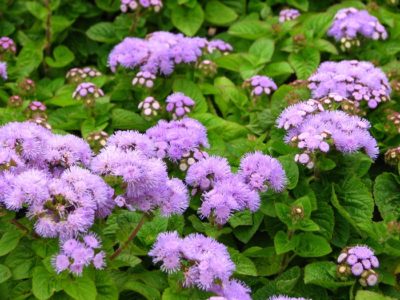
Image source: scitechdaily
Mosquito season is here, but does that mean that we need to go stock up on Deet? Actually, no. There is a better way. While mosquitoes can be quite persistent, especially in the evening, there are some natural alternatives to spraying yourself and your family down with chemicals. Several plants have been found to deter mosquitoes, and by combining these in planters or in flower beds in higher traffic areas you can help discourage your little pesky visitors from crashing your family’s fun.
1. Citronella Geranium (Pelargonium citrosum)
Commonly known as the “mosquito plant,” this geranium grows fairly tall (2 to 3 feet) in summer. It handles pruning well, so don’t be afraid to sculpt it as needed. It appreciates some afternoon shade and is fairly tolerant of drought conditions. Wait until all danger of frost has passed and the soil is warm (about the time you plant tomatoes) before planting this Geranium. Space it 18 to 24 inches apart.
Citronella oil is what mosquitoes find particularly distasteful. To make use of these oils, it’s best to crush the leaves and rub them on your skin. Keep the mosquito plant nearby in a container or pick some of its branches and add them to outdoor bouquets so the leaves are always handy should you need them.
2. Marigolds (Tagetes)
Marigolds have a strong smell and are a natural deterrent of mosquitoes (and other pests). The flowers come in a number of sizes and colors and make excellent additions to gardens, flower beds, container gardens and even window boxes. Marigolds repel a number of pests (though
Order your 2014 Heirloom Solutions seed catalog and get $20 in your account!
they do attract wasps), so they make a welcome addition to gardens. The flowers are edible as well and can be added to salads and soups for both color and flavor. Marigolds do best in full sun and will need deadheaded regularly.
3. Citronella Plant (Cymbopogon nardus or Citronella winterianus)
Citronella, a grass, is considered a weed in some areas due to its ability to take over after a fire, in affect reducing livestock production when more readily accepted plants are squeezed
out. Citronella is a strong smelling grass and in the right place, works to help discourage mosquitoes. It can grow to a height of five or six feet in the ground in warmer climates. In cooler climates, the best approach is to plant it in large pots (with casters on the bottom) so it can be wheeled indoors during the cold
season. Smaller plants are sold at garden centers. These can be added to flower beds and as they grow, you can propagate them by splitting larger clumps into smaller sections and planting them individually. These grasses prefer full sun and well-draining soil.
Citronella scent is one of the main ingredients in many insect repellents. It works by masking more desirable smells to mosquitoes, making people harder to find.
4. Catnip (Nepeta cateria)
Catnip is a fairly easy to grow perennial and has significant mosquito repellant qualities. In 2001, the American Chemical Society, as shared by Science Daily, reported that “nepetalacone, the essential oil in catnip that gives the plant its characteristic odor, is about 10 times more effective at repelling mosquitoes than DEET.”
Catnip is related to mint and can take over as a weed by seeding and underground runners, so be careful where you plant it. It grows well in both containers and the ground. Plant it after the threat of frost is past and space plants apart 18 and 24 inches. To  encourage your plant to achieve a bushy growth, pinch back the growing stems and buds as they form. A small white flower will appear and go to seed eventually.
encourage your plant to achieve a bushy growth, pinch back the growing stems and buds as they form. A small white flower will appear and go to seed eventually.
While mosquitoes disdain coming in close proximity to catnip, it can also be beneficial to crush some of the leaves and spread the oil on your skin. Just be aware that cats find the catnip smell irresistible. To protect plants from being loved to death by cats, you can place small bamboo sticks throughout the plants so cats can’t lie down and roll around in them. You can also put small wire cages over the plants. The stalks will grow up through the tops of the cages, but the roots and base will be protected.
5. Ageratum (Ageratum houstonianum)
 Ageratum is a low-maintenance container plant that tends to annoy mosquitoes. As such it makes an excellent addition to mosquito repellant container gardens as well as flowerbeds. The bright blue, frizzy looking flowers accent large triangular leaves. Like most other mosquito-deterring plants, ageratum gives off a smell that mosquitoes don’t like. Ageratum secretes coumarin, a compound that is often used in mosquito repellants. While crushing the leaves can intensify the smell, it’s not recommended to put the leaves directly on your skin. This ornamental flower grows to a height somewhere between 8 and 18 inches and doesn’t seem to require rich soil to thrive. Place your ageratum in full to partial sun.
Ageratum is a low-maintenance container plant that tends to annoy mosquitoes. As such it makes an excellent addition to mosquito repellant container gardens as well as flowerbeds. The bright blue, frizzy looking flowers accent large triangular leaves. Like most other mosquito-deterring plants, ageratum gives off a smell that mosquitoes don’t like. Ageratum secretes coumarin, a compound that is often used in mosquito repellants. While crushing the leaves can intensify the smell, it’s not recommended to put the leaves directly on your skin. This ornamental flower grows to a height somewhere between 8 and 18 inches and doesn’t seem to require rich soil to thrive. Place your ageratum in full to partial sun.
There are a variety of other herbs that are considered pest control plants. Among these are lavender, basil, lemon balm, lemon thyme, rosemary, horsemint and others. Consider placing a container herb garden on your patio, by your windows and doors, or any other area outside that your family and guests tend to congregate in a lot. While you don’t need to plant your mosquito-deterring plants in pots, the portability that pots allow is a great asset. You can move them outside to wherever family and friends happen to be at the moment, and you can even bring them indoors (with adequate sunlight) to discourage indoor pests. Choose several containers and arrange different kinds of plants in them to produce not only an attractive container garden, but also a readily available, portable mosquito repellant station.
Sign up for Off The Grid News’ weekly email and stay informed about the issues important to you
 Off The Grid News Better Ideas For Off The Grid Living
Off The Grid News Better Ideas For Off The Grid Living







